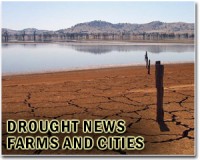| . |  |
. |
Corvallis OR (SPX) Apr 15, 2011 A research group has concluded that forests and other terrestrial ecosystems in the lower 48 states can sequester up to 40 percent of the nation's fossil fuel carbon emissions, a larger amount than previously estimated - unless a drought or other major disturbance occurs. Widespread droughts, such as those that occurred in 2002 and 2006, can cut the amount of carbon sequestered by about 20 percent, the scientists concluded in a recent study that was supported by the National Science Foundation and U.S. Department of Energy. The research, published by scientists from 35 institutions in the journal Agricultural and Forest Meteorology, was based on satellite measurements and dozens of environmental observation sites in the AmeriFlux network. Not all of this data had previously been incorporated into earlier estimates, and the new study provides one of the most accurate assessments to date of the nation's carbon balance. "With this data it appears that our forests and other vegetation can sequester as much as 40 percent of the carbon emissions in the lower 48 states," said Beverly Law, a co-author of the study, professor in the Department of Forest Ecosystems and Society at Oregon State University, and science team chair of the AmeriFlux network. "That's substantially higher than some previous estimates, which indicated these ecosystems could take up the equivalent of only about 30 percent of emissions or less," Law said. "There's still some uncertainty in these data, but it does appear that the terrestrial carbon sink is higher than believed in earlier studies." However, the scientists cautioned that major disturbances, such as droughts, wildfires and hurricanes, can all affect the amount of carbon sequestered in a given year. Large droughts that happened twice in the U.S. in the past decade reduced the carbon sink about 20 percent, compared to a normal year. "With climate change, we may get more extreme or frequent weather events in the future than we had before," Law said. "About half of the United States was affected by the major droughts in 2002 and 2006, which were unusually severe in their spatial extent and severity. And we're now learning that this can have significant effects on the amount of carbon sequestered in a given year." Carbon dioxide, when released by the burning of fossil fuels, forest fires, or other activities, is a major "greenhouse gas" and factor in global warming. But vegetation, mostly in the form of growing evergreen and deciduous forests, can play an important role in absorbing some of the excess carbon dioxide. Such information is important to understand global climate issues and develop policies, the researchers noted. This study examined the carbon budget in the U.S. from 2001 to 2006. Also playing a key role in the analysis was the PRISM climate database at OSU, a sophisticated system to monitor weather on a very localized and specific basis. The period from 2001-06, the researchers noted, had some catastrophic and unusual events, not the least of which was Hurricane Katrina and the massive destruction it caused. It also factored in the 2002 Biscuit Fire in southwest Oregon, one of the largest forest fires in modern U.S. history. The research found that the temperate forests in the eastern U.S. absorbed carbon mainly because of forest regrowth following the abandonment of agricultural lands, while some areas of the Pacific Northwest assimilated carbon during much of the year because of the region's mild climate. Crop lands were not considered in determining the annual magnitude of the U.S. terrestrial carbon sink, because the carbon they absorb each year during growth will be soon released when the crops are harvested or their biomass burned. The study was led by Jingfeng Xiao, a research assistant professor at the Complex Systems Research Center, Institute for the Study of Earth, Oceans, and Space, at the University of New Hampshire. "Our results show that U.S. ecosystems play an important role in slowing down the buildup of carbon dioxide in the atmosphere," the researchers wrote in their conclusion. "The dominant sources of the recent interannual variation included extreme climate events (e.g., drought) and disturbances (e.g., wildfires, hurricanes)."
Share This Article With Planet Earth
Related Links - Climate Science News - Modeling, Mitigation Adaptation
 Mideast drought, factor in unrest, worsens
Mideast drought, factor in unrest, worsensCairo (UPI) Apr 1, 2011 Syrian President Bashar Assad is struggling to contain spreading unrest that threatens his regime by dangling the prospect of political reform but the crisis goes deeper than that. Damascus has for years been grappling, unsuccessfully, with a crippling water shortage that analysts say threatens the entire region. It was no coincidence the upheaval in Syria that began two weeks ag ... read more |
|
| The content herein, unless otherwise known to be public domain, are Copyright 1995-2010 - SpaceDaily. AFP and UPI Wire Stories are copyright Agence France-Presse and United Press International. ESA Portal Reports are copyright European Space Agency. All NASA sourced material is public domain. Additional copyrights may apply in whole or part to other bona fide parties. Advertising does not imply endorsement,agreement or approval of any opinions, statements or information provided by SpaceDaily on any Web page published or hosted by SpaceDaily. Privacy Statement |